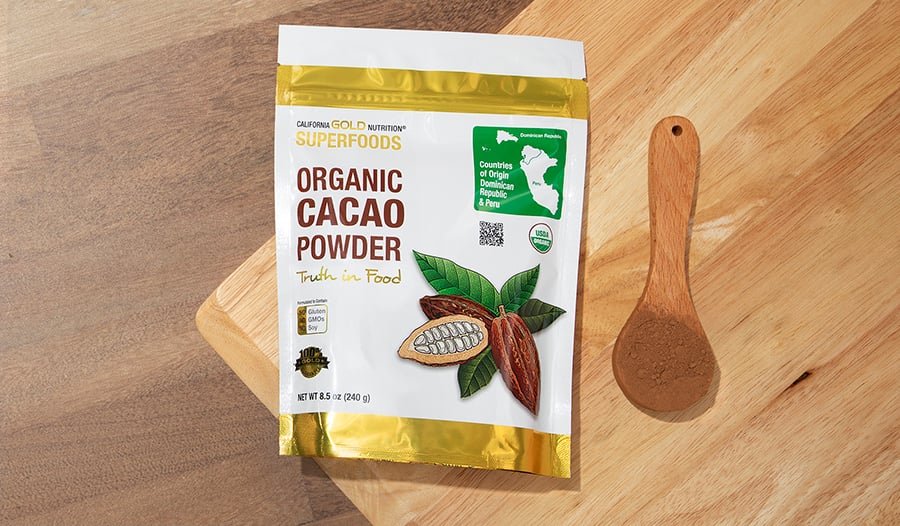Desfășurarea antioxidanților ciocolatei și a beneficiilor dispoziției din cacao

Istoria cacaoului
Cacao este semințele din micul copac veșnic verde Theobroma cacao, folosit pentru a face cacao, unt de cacaoși ciocolată. Originar din America de Sud, cacao a fost domesticit de Maya și cultivat în America Centrală. Cuvântul cacao provine mai departe de Olmec, o civilizație bazată în jurul marginii sudice a Golfului Mexic. Cel mai probabil, aztecii au cooptat o serie de credințe mayașe despre cacao și au folosit boabele în numeroase tipuri de ritualuri și ceremonii. La acea vreme, numai masculii de statură înaltă sau, ocazional, sacrificii umane aveau voie să imbine cacao sub orice formă.
În anii 1500, exploratorii europeni au început să se confrunte cu consumul de cacao și cacao în toată Mesoamerica. Prezentat curții spaniole ca băutură în 1544, cacao s-a răspândit ca băutură și medicament în toată Europa de Vest în următorul secol. Pe măsură ce cererea de cacao a crescut, au fost create plantații pentru cultivarea și cultivarea boabelor de cacao pentru piața europeană în plină expansiune.
Utilizarea și răspândirea cacaoului sunt similare cu alte două băuturi populare care conțin cofeină: ceaiul și cafeaua. În timp ce ciocolata este adesea considerată junk food, cacao a fost venerat istoric pentru proprietățile sale medicinale. Mai recent, cercetările privind ciocolata, cacao și cacao au început să refacă valoarea potențială a ciocolatei și a cacao ca medicament.
Ce face ca cacao să fie un superaliment?
Boabele de cacao sunt acum adesea considerate un superaliment. Fasolea conține niveluri semnificative de carbohidrați, grăsimi, proteine și fibre. În plus, cacao are o serie de constituenți care influențează probabil beneficiile sale medicinale potențiale, inclusiv polifenoli, metilxantine și alți constituenți bioactivi.
Cacao este bogat în polifenoli?
Un număr tot mai mare de plante medicinale sunt recunoscute pentru beneficiile potențial derivate din conținutul lor de polifenoli. Turmeric, ceai verde, extract de scoarță de pinși semințe de struguri sunt toate bogate în polifenoli. Toate aceste plante sunt în curs de investigare activă, cercetările sugerând potențiale efecte asupra sănătății mentale și fizice.
În mod similar, cacao este, de asemenea, din ce în ce mai recunoscut ca o plantă bogată în polifenoli.
Polifenolii sunt compuși care dau adesea plantelor culorile lor profunde. Acești compuși sunt, de asemenea, notabili pentru că sunt antioxidanți puternici și prezintă potențiale beneficii antiinflamatorii. Polifenolii din ciocolată, în special, par să beneficieze inima. Dovezile preliminare sugerează că consumul regulat de ciocolată neagră poate ajuta la scăderea coagulării problematice a sângelui, la reducerea tensiunii arteriale, la echilibrarea zahărului din sânge, la creșterea colesterolului „bun” de lipoproteine cu densitate mare (HDL) și la reducerea colesterolului „rău” de lipoproteine cu densitate scăzută (LDL). Pentru bolile de inimă, colesterolul LDL devine în primul rând un factor de risc atunci când este deteriorat sau oxidat. Polifenolii din cacao s-au dovedit, de asemenea, că ajută la prevenirea oxidării LDL.
Dar beneficiile polifenolilor din cacao nu se termină aici. De asemenea, par să joace un rol în sănătatea creierului. Deși cercetarea este în mare parte la animale, sugerează că polifenolii din cacao au efecte antioxidante care pot îmbunătăți aspectele învățării, memoriei și cunoașterii. S-a demonstrat, de asemenea, că polifenolii din ciocolată traversează bariera hematoencefalică și cresc fluxul sanguin.
Alte beneficii ale polifenolilor de cacao includ creșterea factorului neurotrofic derivat din creier (BDNF). BDNF este un factor de creștere care încurajează creșterea și dezvoltarea celulelor cerebrale noi. De asemenea, se presupune că joacă un rol în reducerea simptomelor depresive. Având în vedere beneficiile potențiale ale polifenolilor din ciocolată, nu este surprinzător faptul că cacao este promovat ca supliment anti-îmbătrânire.
Cacao conține metilxantină?
Metilxantinele includ cofeina și compușii înrudiți găsiți în ciocolată, ceai, guaranași cafea, printre alte surse. În timp ce principala metilxantină din ciocolată este teobromina, conține, de asemenea, cantități semnificative de cofeină.
Metilxantinele sunt bine cunoscute pentru efectele lor producătoare de energie. Metilxantinele furnizează energie în principal prin efectele lor asupra receptorilor de adenozină din sistemul nervos central. Receptorii adenozinei au o serie de funcții, dar joacă, de asemenea, un rol cardinal în provocarea oboselii și oboselii. Adenozin trifosfat (ATP) furnizează energie celulelor. Pe măsură ce această energie este consumată pe parcursul zilei, adenozina rămâne. Pe măsură ce nivelurile de adenozină cresc, începeți să vă simțiți obosiți.
Metilxantinele nu vă oferă mai multă energie; ele funcționează prin inhibarea experienței de oboseală prin blocarea receptorilor de adenozină. Receptorii adenozinei au, de asemenea, efecte asupra inimii și plămânilor, acesta din urmă fiind probabil motivul pentru care ciocolata a găsit o utilizare istorică în tratamentul astmului.
Pe baza acestor efecte, s-a demonstrat că metilxantinele stimulează starea de spirit, nivelul de energie și concentrarea. Într-un studiu, cercetătorii au arătat că metilxantinele izolate au fost principala sursă de dispoziție și efecte energizante ale ciocolatei. Cercetătorii au comparat consumul de cacao brut cu metilxantine purificate. Starea de spirit și efectele energizante au fost practic identice.
Ce alți compuși bioactivi conține cacao?
De asemenea, în ciocolată sunt prezenți o serie de alți compuși potențial bioactivi. Acești compuși includ feniletilamina și anandamida.
Feniletilamină
Feniletilamina modulează efectele altor neurotransmițători (cum ar fi dopamina și serotonina) în timp ce acționează ca un neurotransmițător. În general, se crede că feniletilamina acționează ca un stimulent, crescând nivelul de energie și îmbunătățind starea de spirit. Alte cercetări au legat potențial compusul de funcția cognitivă și de memorie, precum și de prevenirea unui număr de afecțiuni de sănătate mintală, inclusiv depresia și boala Parkinson. Există afirmații că feniletilamina poate fi unul dintre constituenții care fac ciocolata un afrodisiac, deși această afirmație este departe de a fi dovedită.
Anandamidă
Anandamida a fost primul endocannabinoid descoperit în corpul uman. Cu alte cuvinte, anandamida este primul compus cunoscut a fi produs de organism care stimulează aceiași receptori ca tetrahidrocanabinolul (THC) din canabis. Oamenii de știință au postulat că anandamida ar putea face parte din plăcerea și atracția ciocolatei și a cacaoului prin interacțiuni cu sistemul canabinoid. De asemenea, ar putea contribui la natura dependentă a ciocolatei, deși sunt necesare mai multe cercetări, deoarece nivelurile de anandamidă sunt destul de scăzute.
Beneficiile pentru sănătatea mintală a cacaoului
Deși cercetarea nu a fost pe deplin consecventă, există încă sugestii puternice că cacao ar putea avea unele beneficii semnificative pentru sănătatea mintală.
Un studiu recent a administrat ciocolată neagră sau ciocolată albă unui grup de adulți tineri timp de 30 de zile. Ciocolata neagra a imbunatatit cognitia si a crescut nivelul factorului de crestere a nervilor, un factor de crestere implicat in sustinerea cresterii si dezvoltarii celulelor creierului. Interesant este că beneficiile cognitive s-au menținut timp de cel puțin trei săptămâni după ce s-a încheiat consumul de ciocolată neagră.
Într-un studiu separat, adulților tineri sănătoși li s-a administrat fie 70% ciocolată neagră, 85% ciocolată neagră, fie deloc ciocolată timp de trei săptămâni. În timp ce 85% ciocolată neagră a îmbunătățit starea de spirit, ciocolata neagră de 70% nu a fost dovedită a fi benefică pentru stările de dispoziție. Analiza microbiotei gastrointestinale a subiecților studiați a constatat că ciocolata neagră de 85% a produs modificări benefice în microbiota sau flora intestinală. La subiecții care au consumat 85% ciocolată neagră, s-a constatat o diversitate crescută de bacterii benefice, împreună cu un nivel crescut de bacterii specifice care ambele ar fi putut face parte din efectele benefice asupra stării de spirit.
Alte cercetări sugerează creșterea calmului și a mulțumirii cu consumul de ciocolată neagră. Participanții la studiu au primit o băutură de ciocolată neagră cu cantități diferite de polifenoli. La subiecții cărora li s-a administrat cea mai mare doză timp de 30 de zile, calmul și mulțumirea au fost semnificativ crescute. În mod similar, la subiecții predispuși la anxietate, dovezile sugerează că ciocolata poate ajuta la scăderea nivelului de anxietate.
Un studiu efectuat pe subiecți mai în vârstă cărora li s-a administrat ciocolată, fructe de pădure roșii sau ambele a constatat îmbunătățiri ale funcției executive. Funcția executivă este în general considerată a avea trei componente: memoria de lucru, flexibilitatea gândirii și autocontrolul.
Într-un studiu mic, subiecților cu oboseală cronică li s-a administrat o băutură de ciocolată cu conținut ridicat de polifenoli sau placebo timp de opt săptămâni. Când pacienții luau băutura adevărată de ciocolată, simptomele generale ale oboselii cronice au fost reduse cu o treime. În plus, scorurile de anxietate au fost, de asemenea, reduse cu o treime, scorurile de depresie îmbunătățindu-se cu aproape jumătate.
În timp ce majoritatea studiilor anterioare au evaluat consumul zilnic, pe termen lung de ciocolată, un studiu asupra efectelor acute sugerează, de asemenea, beneficii. Subiecții care au consumat o singură doză dintr-o băutură de ciocolată cu conținut ridicat de polifenol au avut rezultate mai bune la testarea cererii cognitive.
Concluzie
Cacao conține numeroase componente care prezintă proprietăți antioxidante și pot aduce beneficii sănătății mintale și cogniției. Alte cercetări sugerează, de asemenea, că ciocolata și cacao au efecte potențial pozitive asupra sănătății inimii și a nivelului de zahăr din sânge. În timp ce sunt necesare mai multe cercetări, cele mai bune rezultate pentru susținerea sănătății mintale sunt probabil observate cu soiurile de ciocolată mai închisă care conțin niveluri mai ridicate de constituenți activi. Având în vedere cât de multă ciocolată și cacao sunt adesea savurate ca gustări sau dulciuri, este plăcut să știți că utilizate corect, acestea pot oferi, de asemenea, beneficii semnificative pentru sănătate.
Referințe:
- Dala-Paula BM, Dumnezeu VL, Tavano OL, Gloria MBA. Bioaccesibilitatea in vitro a aminoacizilor și aminelor bioactive în ciocolată neagră cu cacao 70%: ceea ce mănânci și ce primești. Food Chem. 2021; 343:128397. doi: 10.1016/j.foodchem.2020.128397
- Devaraj S, Vega-López S, Kaul N, Schönlau F, Rohdewald P, Jialal I. Suplimentarea cu un extract de scoarță de pin bogat în polifenoli crește capacitatea antioxidantă plasmatică și modifică profilul lipoproteinelor plasmatice. Lipide. 2002; 37 (10): 931-934. doi: 10.1007/s11745-006-0982-3
- Martie V, De Petrocellis L, Fezza F, Ligresti A, Receptorii Anandamide necesită T. Prostaglandine Leukot Essential Gras Acid. 2002; 66 (2-3): 377-391. doi: 10.1054/plef.2001.0349
- di Tomaso E, Beltramo M, Piomelli D. Cannabinoizi cerebrali în ciocolată. Natura. 1996; 382 (6593): 677-678. doi: 10.1038/382677a0
- Dillinger TL, Barriga P, Escárcega S, Jimenez M, Salazar Lowe D, Grivetti LE. Mâncarea zeilor: leac pentru umanitate? O istorie culturală a utilizării medicinale și rituale a ciocolatei. J Nutr. 2000; 130 (8S Supliment) :2057S-72S. doi: 10.1093/jn/130.8.2057s
- Gratton G, Weaver SR, Burley CV și colab. Flavanolii dietetici îmbunătățesc oxigenarea corticală cerebrală și cunoașterea la adulții sănătoși. Science Rep. 2020; 10 (1) :19409. Publicat în 2020 24 noiembrie. doi:10.1038/s41598-020-76160-9
- Hei CL. Legea CL. Suzannah S. Misnawi, Cloke M. Polifenoli în cacao (Theobroma cacao L.). Jurnalul asiatic de alimentație și agroindustrie. 2009; 2 (4): 702-722.
- Jin T, Song Z, Weng J, Fantus IG. Curcumina și alți polifenoli dietetici: mecanisme potențiale ale acțiunilor metabolice și terapie pentru diabet și obezitate. Am J Physiol Endocrinol Metab. 2018; 314 (3): E201-E205. doi: 10.1152/ajpendo.00285.2017
- Kim HS, Quon MJ, Kim JA. Noi perspective asupra mecanismelor polifenolilor dincolo de proprietățile antioxidante; lecții din polifenolul ceaiului verde, epigalocatechin 3-galat. Redox Biol. 2014; 2:187-195. Publicat în 2014 10 ianuarie. doi:10.1016/j.redox.2013.12.022
- Loor Solorzano RG, Fouet O, Lemainque A și colab. Perspectivă asupra originii sălbatice, migrației și istoriei domesticirii soiului nacional Theobroma cacao L. cu aromă fină din Ecuador [corecția publicată apare în PLoS One. 2013; 8 (2). doi: 10.1371/adnotation/2357f0f1-7dc3-4781-afb0-29a8ce56b3f0]. PLoS One. 2012; 7 (11): e48438. doi: 10.1371/journal.pone.0048438
- MPhil EA. Consumul de cacao și ciocolată — există afrodisiace și alte beneficii pentru sănătatea umană? S Afr J Clin Nut. 2008; 21 (3).
- Martin FP, Antille N, Rezzi S, Kochhar S. Experiențele zilnice de mâncare cu ciocolată și gustări fără ciocolată afectează anxietatea postprandială, energia și stările emoționale. Nutrienți. 2012; 4 (6): 554-567. doi: 10.3390/nu4060554
- Pase MP, Scholey AB, Pipingas A și colab. Polifenolii din cacao îmbunătățesc stările pozitive de dispoziție, dar nu și performanța cognitivă: un studiu randomizat, controlat cu placebo. J Psihofarmacol. 2013; 27 (5): 451-458. doi: 10.1177/0269881112473791
- Pucciarelli DL, Grivetti LE. Utilizarea medicinală a ciocolatei la începutul Americii de Nord. Mol Nutr Food Res. 2008; 52 (10): 1215-1227. doi: 10.1002/mnfr.200700264
- Sathyapalan T, Beckett S, Rigby AS, Mellor DD, Atkin SL. Ciocolata bogată în polifenoli de cacao poate reduce povara simptomelor în sindromul oboselii cronice. Nutr J. 2010; 9:55. Publicat în 2010 noiembrie 22. doi:10.1186/1475-2891-9-55
- Scholey AB, franceza SJ, Morris PJ, Kennedy DO, Milne AL, Haskell CF. Consumul de flavanoli de cacao are ca rezultat îmbunătățiri acute ale dispoziției și performanței cognitive în timpul efortului mental susținut. J Psihofarmacol. 2010; 24 (10): 1505-1514. doi: 10.1177/0269881109106923
- Shi J, Yu J, Pohorly JE, Kakuda Y.Polifenolici în semințele de struguri - biochimie și funcționalitate. J Med Food. 2003; 6 (4): 291-299. doi: 10.1089/109662003772519831
- Shin JH, Kim CS, Cha L și colab. Consumul de 85% ciocolată neagră cu cacao îmbunătățește starea de spirit în asociere cu modificările microbiene intestinale la adulții sănătoși: un studiu controlat randomizat. J Nutr Biochem. 2022; 99:108854. doi: 10.1016/j.jnutbio.2021.108854
- Smit HJ, Gaffan EA, Rogers PJ. Metilxantinele sunt constituenții psiho-farmacologic activi ai ciocolatei. Psihofarmacologie (Berl). 2004; 176 (3-4): 412-419. doi: 10.1007/s00213-004-1898-3
- Sokolov AN, Pavlova MA, Klosterhalfen S, Enck P. Ciocolata și creierul: impactul neurobiologic al flavanolilor de cacao asupra cunoașterii și comportamentului. Neurosci Biobehav Rev. 2013; 37 (10 Pt 2): 2445-2453. doi: 10.1016/j.neubiorev.2013.06.013
- Sumiyoshi E, Matsuzaki K, Sugimoto N și colab. Consumul subcronic de ciocolată neagră îmbunătățește funcția cognitivă și eliberează factori de creștere a nervilor: un studiu randomizat în grup paralel. Nutrienți. 2019; 11 (11) :2800. Publicat în 2019 noiembrie 16. doi:10.3390/nu11112800
- Tan TYC, Lim XY, Yeo JHH, Lee SWH, Lai NM. efectele asupra sănătății ciocolatei și cacao: o revizuire sistematică. Nutrienți. 2021; 13 (9) :2909. Publicat în 2021 24 august. doi:10.3390/nu13092909
- Verna R. Istoria și știința ciocolatei. Malaezia J Pathol. 2013; 35 (2): 111-121.
- Zięba K, Makarewicz-Wujec M, Kozłowska-Wojciechowska M. Mecanisme cardioprotectoare ale cacao. J Am Coll Nutr. 2019; 38 (6) :564-575. doi: 10.1080/07315724.2018.1557087
Declarație de declinare a responsabilității:Acest blog nu are ca scop să ofere un diagnostic.













































































 Cuprins
Cuprins
















